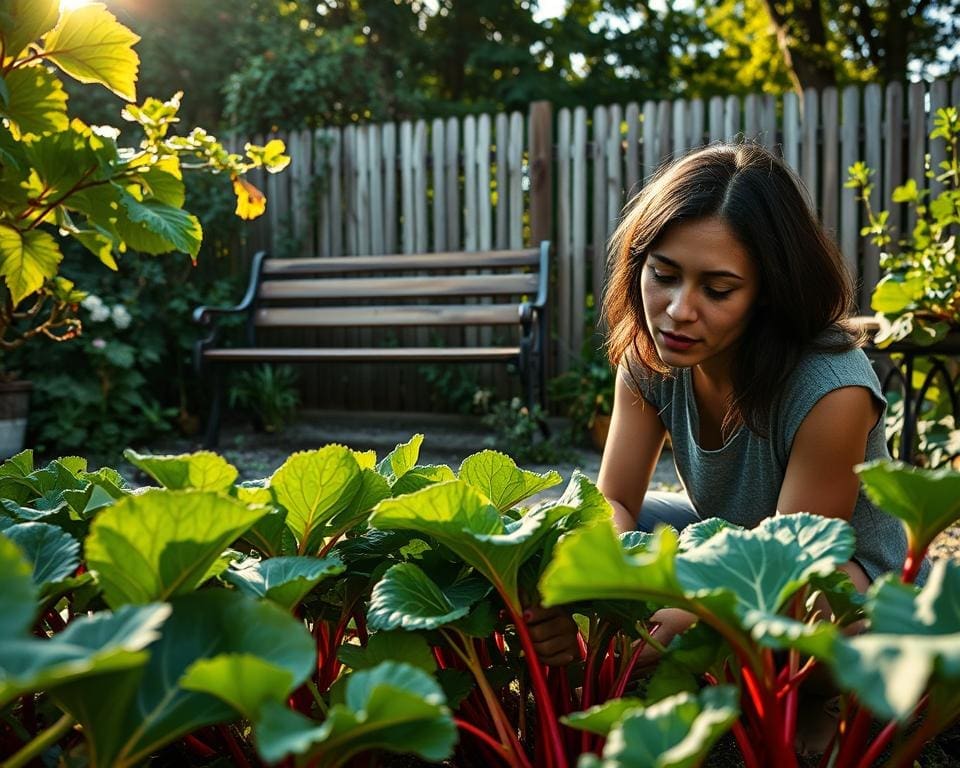In an age where technology often distances us from nature, the question arises: can you reconnect while harvesting rhubarb? This unique interaction with plants provides a sensory experience, enabling a deeper bond with the earth. Rhubarb cultivation not only rewards us with vibrant produce, but also encourages mindfulness and a chance to engage fully with the world around us. The tactile sensations of working the soil and the delight of gathering fresh rhubarb can awaken a sense of joy and connection that is often overlooked in our daily lives. The anticipation of enjoying homegrown produce offers an added layer of satisfaction, igniting curiosity about the emotional and psychological benefits of organic gardening, particularly through the simple act of harvesting rhubarb.
The Art of Harvesting Rhubarb
Harvesting rhubarb is a skill that combines patience and technique, which can greatly enhance your experience in organic gardening. Knowing the right time to harvest is vital for ensuring exceptional flavour and quality. Look for vibrant, firm stalks with a bright hue; ideally, rhubarb should be harvested in spring when the leaves are lush and the stalks are robust.
When it comes to cutting the stalks, use a sharp knife to avoid damaging the plant. It’s important to *gently* twist the stalk while cutting at the base to encourage new growth. Harvesting only the older stalks helps maintain the health of the plant, as younger stalks will continue to thrive and provide an ongoing supply of your beloved homegrown rhubarb.

Appreciating the aesthetic appeal of rhubarb not only enriches your garden but elevates your culinary creations. Homegrown rhubarb adds a unique tartness to dishes, making any meal special. By embracing the art of harvesting rhubarb, you connect with the land and enjoy the fruits of your labour while reinforcing the values of organic gardening. A little dedication goes a long way towards crafting a flourishing garden that provides both beauty and nourishment.
Understanding Rhubarb Cultivation
Successful rhubarb cultivation requires careful attention to various factors, starting with soil preparation. Rhubarb thrives in nutrient-rich, well-drained soil, which provides the ideal foundation for vigorous growth. Incorporating organic matter, such as compost, helps improve soil structure and fertility, essential for nurturing robust plants.
When it comes to watering, consistency is key. Rhubarb requires regular moisture, especially during dry spells. A deep watering approach encourages the roots to establish themselves deeply, leading to healthier plants. Sunlight is equally important; rhubarb flourishes in full sun but can tolerate some partial shade. Understanding the right balance enhances the robustness of the plants.
Pest management is an integral part of growing rhubarb sustainably. Regular monitoring allows for early detection of issues, and employing organic pest control methods ensures minimal impact on the environment. Crop rotation is another crucial practice that maintains soil health while reducing pest and disease buildup, promoting a sustainable growth cycle.
By embracing these practices, gardeners can nurture their rhubarb from seedling to harvest. This journey not only yields delicious produce but also fosters a deeper connection to the land, embodying the principles of sustainability throughout the cultivation process.
Can you reconnect while harvesting rhubarb?
Engaging with nature offers a profound opportunity for individuals to reconnect with themselves and their surroundings. Activities like harvesting rhubarb encourage a deeper awareness of the world and enhance emotional well-being. The garden, while a place of productivity, serves as a sanctuary for mindfulness and self-discovery.
The Benefits of Engaging with Nature
Spending time outdoors has numerous mental health benefits. Engaging with the natural environment can uplift mood and reduce stress. The rhythmic act of harvesting rhubarb allows individuals to:
- Immerse themselves in the serenity of nature.
- Experience calmness through physical activity.
- Enhanced focus on the present moment.
Such experiences facilitate an organic connection to the earth, encouraging a sense of place and purpose in daily life.
Mindfulness and Gardening
Practicing mindfulness can transform gardening from a mere task into a meditative experience. All aspects of harvesting rhubarb—from the feel of the soil to the scent of the plants—promote a tranquil state of mind. By concentrating on each movement, individuals can cultivate a sanctuary for themselves, where mindfulness flourishes. Gardening becomes not only an activity but a ritual that reconnects individuals with nature, fostering a state of peace.
Organic Gardening Practices for Homegrown Rhubarb
Embracing organic gardening practices can transform your efforts in cultivating homegrown rhubarb. This approach prioritises the health of both plants and the surrounding environment, fostering sustainability in every aspect. One fundamental practice is composting, which enriches the soil with nutrients while promoting microbial life. Healthy soil leads to resilient plants, ultimately resulting in a better yield of rhubarb.
Natural pest control methods are another cornerstone of organic gardening. By attracting beneficial insects and utilising companion planting, gardeners can effectively manage pests without resorting to harmful chemicals. This harmonious balance enhances the biodiversity of your garden, creating an ecosystem where homegrown rhubarb can thrive.
Using organic fertilisers improves the overall nutritional profile of your rhubarb. These substances not only nourish plants but also contribute to sustainability by minimising pollution and preserving soil quality. As you savour the flavours of your freshly harvested rhubarb, you will appreciate the impact of chemical-free growing practices on both taste and nutrition.
The Joy of Seasonal Produce
Embracing the joy of seasonal produce brings a unique satisfaction, especially when it comes to harvesting rhubarb. This delightful vegetable, often treated as a fruit, boasts a wonderfully tart flavour that can enhance many dishes. With this seasonal star in hand, one can explore various ways to truly appreciate its versatility in the kitchen.
Making the Most of Your Harvest
Making the most of your harvest requires some creativity and willingness to experiment. Consider preserving rhubarb by freezing it or making delicious jams that will last long after the growing season ends. Incorporating rhubarb into your dietary routine means enjoying its health benefits throughout the year. When harvesting rhubarb, select stalks that are firm and vibrant, ensuring the best quality for your culinary creations.
Creative Ways to Use Rhubarb in the Kitchen
There are countless creative ways to use rhubarb beyond the traditional desserts. Think about crafting savoury dishes, such as rhubarb chutneys that perfectly complement grilled meats. Rhubarb can also shine in salads, adding a refreshing tanginess that balances richer ingredients. Classic recipes like rhubarb crumble or pie remain timeless, showcasing the vegetable’s ability to delight the palate. As you explore these options, remember that your creativity holds the key to making the most of this seasonal treasure.
Connecting with the Garden-to-Table Movement
The garden-to-table movement embodies a profound connection between the environment and our daily sustenance. By embracing this philosophy, one not only nurtures their own health but also fosters a deeper bond with the community and ecosystem. Homegrown rhubarb stands as a prime example of this synergy, exemplifying the joy of cultivating one’s own food and enhancing the culinary experience.
Harvesting produce, such as rhubarb, reinforces the importance of sustainable practices in our food systems. Each stalk picked represents a choice to engage in local food sourcing, reducing reliance on industrial agriculture. This mindful approach to eating not only elevates the quality of one’s meals but also champions sustainability as a core value in personal and communal living.
As individuals become more involved in their food journeys, the impact radiates beyond the kitchen. Community gardens and local farms foster relationships among neighbours, creating networks of support that echo the principles of sustainability. Sharing recipes or tips on growing homegrown rhubarb strengthens these connections, sparking conversations that inspire others to explore their own garden-to-table journeys.
Sustainability in Growing Rhubarb
Embracing sustainability in rhubarb cultivation not only fosters a healthier garden but also contributes to environmental preservation. Organic gardening practices, such as composting and crop rotation, play a pivotal role in maintaining soil health and nurturing the ecosystem. By reducing reliance on synthetic fertilizers and pesticides, gardeners can protect vital pollinators and encourage biodiversity within their plots.
Moreover, sustainable rhubarb cultivation helps mitigate the effects of climate change. By choosing local and seasonal produce, enthusiasts can reduce their carbon footprint, supporting community economies and promoting food sovereignty. Each stalk of rhubarb represents a commitment to responsible gardening that champions sustainability and ecological balance.
Through the thoughtful integration of sustainable practices, gardeners can enjoy the fruits of their labour while cultivating a thriving environment. This connection between healthy eating and environmental stewardship reinforces the interconnectedness of our ecosystems. As we take pride in our rhubarb harvests, let us remember that our actions today can pave the way for a greener tomorrow.









